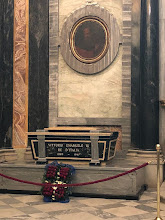Repatriation of Vittorio Emanuele III sparked anger
The remains of Italy’s wartime king, Vittorio Emanuele III, were returned to Italian soil on this day in 2017, 70 years after his death in exile in Egypt.
Vittorio Emanuele III's original funeral, which
took place in Alexandria, Egypt in 1947
His body had been buried in St. Catherine’s Catholic Cathedral in Alexandria since 1947, when he died at the age of 78, a year and a half after abdicating in favour of his son, Umberto II.
His remains were flown to Italy by military aircraft for reburial at his family’s mausoleum at the Sanctuary of Vicoforte, a church in the province of Cuneo, Piedmont. At the same time, the body of his wife, Queen Elena, who had died in France in 1952, was flown to Italy from Montpelier, so that they could be buried side by side.
Vittorio Emanuele’s coffin, draped in a flag bearing the coat of arms of the Savoy family, was taken from the plane at Cuneo’s small Levaldigi airport and escorted to the Sanctuary solely by local officials, including the prefect vicar, the local village mayor and the president of Cuneo’s Chamber of Commerce. Only a handful of people were allowed in the church for the interment ceremony.
 |
| Vittorio Emanuele III, pictured with Mussolini (left) and Hitler in Rome in 1938, was a flawed figure to many Italians |
Vittorio Emanuele enjoyed popularity at times during his 46-year reign, enjoying the nickname Re soldato - the soldier king - after Italy’s victory in World War One, and Sciaboletta - little sabre - because his diminutive size - he was only five feet tall - required the sword of his military uniform to be shortened.
But his reputation was fatally damaged by the decisions he took during the time of Benito Mussolini’s Fascists.
When Mussolini's Blackshirts marched on Rome in 1922, he not only refused the government request to declare martial law, he then handed power to Mussolini, inviting him to be prime minister.
Many refused to forgive him for signing Mussolini’s 1938 racial laws that harshly discriminated against Jews.
He did order Mussolini’s arrest in 1943 when it became obvious that Italy’s war was going to end in defeat. But he attracted more criticism for taking 40 days to agree an armistice with the Allies, which gave the Germans time to entrench themselves in northern Italy and even to free Mussolini from his house arrest in the mountains of Abruzzo.
 |
| Vittorio Emanuele as a baby with his mother, Queen Margherita |
It was not enough to persuade Italian voters, however. Following the referendum result, all male members of the monarchy and their descendants were ordered to leave the country in a ban that remained in place until 2002.
The decision to bury the late monarch in relative obscurity attracted criticism from members of his family. Italy’s first two Savoy kings, Vittorio Emanuele II and Umberto I, and its first queen, Margherita, were all buried at the Pantheon in Rome.
Emanuele Filberto, Vittorio Emanuele III and Elena’s great-grandson, was quoted as saying that while he was pleased with the return of his ancestors to Italy, he believed that all members of the House of Savoy deserved to be in the Pantheon.
But this was strongly opposed by historians, on the grounds that the circular former Roman temple was traditionally a place where Italians of high esteem were laid to rest.
It also provoked an angry response from Rome’s Jewish community. Like other Italians of Jewish heritage, they could never forgive the king’s co-operation with Mussolini. But they were also sensitive to the proximity of the Pantheon to the city’s former ghetto, which saw more than 1,000 residents rounded up and sent to their death in concentration camps in 1943.
Travel tip:
The ex-monarch's tomb at
the Sanctuary of Vicoforte
The city of Cuneo, which developed at the confluence of the Stura and Gesso rivers, is set out in a grid system with a large, elegant central square, Piazza Galimberti, one of the largest squares in Italy, after Piazza del Plebiscito in Naples. Surrounded by neo-classical buildings, it has a large statue of Giuseppe Barbaroux, the author of the Albertine Statute that formed the constitution of the Kingdom of Sardinia-Piedmont in 1848. The square is named after Duccio Galimberti, one of the heroes of the Italian resistance in the Second World War. Cuneo had been acquired by the Duchy of Savoy in 1382 and remained an important stronghold of the Savoy state for many centuries.

The Pantheon in Rome, built in AD 118, contains
the remains of many notable Italians
Travel tip
The Pantheon in Piazza della Rotonda in Rome is considered to be Rome’s best preserved ancient building. It was built in AD 118 on the site of a previous building dating back to 27 BC. It was consecrated as a church in the seventh century. In addition to Vittorio Emanuele II, his son, Umberto I, and his wife, Queen Margherita, the Pantheon contains the tombs of the painters Raphael and Annibale Carracci, the architect Baldassare Peruzzi and the composer Arcangelo Corelli.
Also on this day:
546: Rome falls to the Ostrogoths
1538: Pope Paul III excommunicates Henry VIII of England
1749: The birth of composer Domenico Cimarosa
1859: The birth of painter Ettore Tito
1894: The birth of WW1 pilot Leopoldo Eleuteri
1981: Red Brigades seize NATO boss Dozier















